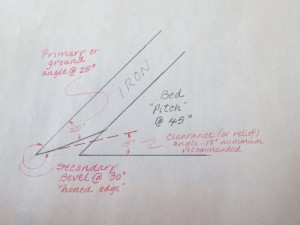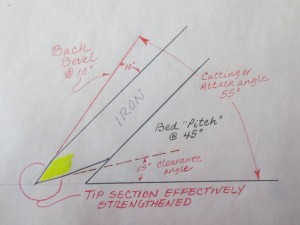Back bevel or higher pitch – which is better?
Most of you know that I am not a big fan of honing back bevels on plane irons. I believe that many inexperienced plane users allow themselves to be mislead, thinking that a back angle (bevel) is going to be some type of magic pill. But after a crafts person is sufficiently confident in their ability to sharpen and maintain appropriate cutting geometry, the use of a back bevel can be very beneficial.
Several days ago I was working in my friend, Les’, shop. He asked me if I’d take a look at his L-N #4 that he had set up with a York pitch (50°) frog. He wasn’t very happy with the surface he was getting on a piece of cherry stock. The stock was not particularly gnarly, but there was a grain direction change, right in the middle. The iron was the same that had been removed from the Common pitch (45°) frog. Les, who is always meticulous about the condition of edge tools, said that he believed the iron was sharp. But I, “doubting Thomas” that I am, suggested that we test the edge. Sure enough, the iron sliced a piece of unsupported paper easily. Next, it trimmed a neat bare patch on the back of my forearm. But upon closer inspection under a loop, it was clear that there were some tiny edge fractures present.
Cogitation began. Increasing the pitch angle of a bench plane (bevel down), supposedly increases the tool’s ability to work in very dense and/or highly figured stock. Obviously, either condition is a challenge to shearing tools. And an increase in pitch causes an increase in the amount of effort required to push the shearing edge through the material. Neither of us had ever experienced a similar problem when using an iron that was back beveled to effectively create a higher pitch. Could back beveling be better than increasing pitch? Turns out, yes. Maybe.
Take a look at the following diagrams (Please note that, for the purpose of illustrating the problem, I’ve used Common Pitch (45°) and Middle Pitch (55°) for the examples.)
When a back bevel in employed, the increased included angle strengthens the tip of the iron. The clearance (relief) angle is kept to a minimum, thereby providing the greatest possible amount of support to the iron.
When a conventionally prepared iron (25° primary bevel, 30° secondary bevel) is secured to a higher pitch bed (frog), the clearance angle significantly increases and the amount of unsupported surface significantly decreases. I believe that the tip section would be effectively weakened by these two factors.
It may be appropriate to increase both primary and secondary bevel angles in order to increase tip section strength and reduce clearance thereby increasing the amount of support surface. It is common for adjustable scraper planes (Stanley 12, 112, 212) to be ground at 45°. But these tools are rarely used at attack angles under 90°. We need to do some physical testing, as there seems to be very little, if any, information available on the matter. If anyone has any thoughts and/or experiences on this question, please share them with us.
Explore posts in the same categories: Uncategorized


February 28, 2015 at 12:15 am
Very interesting observation. Enjoy your posts.
February 28, 2015 at 1:11 am
Was the iron A2 steel? Anecdotal evidence from many people seems to suggest more edge fracture in A2 vs. O1. Without any real testing (but I am a metallurgist), I believe it is because A2 has more carbide phases than O1 which leads to an increase in wear resistance, but a decrease in toughness. There are obviously a lot more in the details of exactly what is going on. I certainly agree with your analysis of the angles and prescription for better results.
February 28, 2015 at 1:16 pm
Hi Dennis and Mark
I believe that the question about the Iron being A2 or O1 are important. In my experience the A2 steel should have a edge bevel of 35 degres to avoid tiny edge fractures caused by the carbide phases. The O1 are a bit tougher, but still not as tough as some of the older laminated irons.
February 28, 2015 at 4:11 pm
Thanks Roald. Our next step to is verify that the iron is A1. Then we’ll regrind and hone (30° and 35°). It’s hard to believe that planes have been around for several thousand years and we are still trying to figure out how to get the best performance from them. Regards.
March 3, 2015 at 4:59 am
second the chipping of A2
February 28, 2015 at 9:03 am
I have done some experiments in this direction with a “planing machine” measuring the forces on the blade. I found a difference in behaviour between a 60 degree cutting angle and 30 degree clearance and 15 degree clearance. The force pushing the edge out of the wood after 100 meter of planing distance was remarkably higher for the 15 degree clearance angle.
The vertical force is a combination of two forces. It is the shaving pushing down on the edge from above and when the edge wears it gets a conex shape, effectively pushing the edge uowards out of the wood. With a high cutting angle and low clearance angle the latter effect is seemingly higher, indidating more wear.
You can read everything about it here:
http://planetuning.infillplane.com/html/mechanics_of_chipbreakers.html
February 28, 2015 at 4:04 pm
Just spent some time on your site. Excellent work. I agree with you that however the included angle of the edge is increased, be it change in pitch or back beveling, the amount of force required to keep the tool engaged is increased, exponentially. This is one of the reasons I try to dissuade novices from using back bevels. That said, higher included angles do impact durability, in terms of toughness. And they do require more frequent maintenance (honing and stropping). The problem with edge fracturing may, indeed, be more of a metallurgical issue as Mark Lauer suggested in an earlier comment. We’re still exploring. Thanks for your input.
February 28, 2015 at 3:44 pm
That is a very good approach you had to analyzing your problem.
First, I concur with the concerns regarding the use of A2. It would nice if it were still an option to buy O1 irons in planes now offered only in A2. While I am sure A2 has great applications, I think it should be the exception and not the rule.
Designing cutting tools involves matching parameters of the material being cut, rake angle, clearance angle, skew. Clearance angle is not something to keep at “a minimum” but something to allow compressed material at the cut to expand behind the edge. In a normal plane bedded at 45 and ground to 25 you would get a 20 degree clearance.
Also, take as an example bevel up planes. These irons should be honed flat on the face side since the ruler trick will mess with the clearance angle. Low angle block planes bedded at 12 deg use that as a clearance angle. Add that to the bevel angle to get the cutting angle.
So when a woodworker has to cut a difficult wood they can change the cutting geometry. We know that the cutting angle can be changed by altering the bedding of the iron or putting a small bevel on the face. The whole geometry of the cutter is not considered with the replacement frog approach and a spare iron ground specifically for the frog.
I’ll offer this as something for someone else to test. If you accept 12 degrees as a minimum clearance angle, you can grind to 30 and keep above that minimum (33 will match it). The 30 will bolster your edge and maintain adequate clearance in all the available pitches.
Steve
February 28, 2015 at 3:59 pm
Just had another look at your diagrams and I see you are using 30 degrees. I was thinking a full bevel of 30 in my comment. I think if your issue is critical to a woodworker, going closer to 30 for the main bevel than 25 will get support further down the frog.
I don’t now how popular these replacement frogs are but maybe buying an O1 iron from someone else makes sense when using one. I tried one at a show and it did a good job on the gnarly stock I was testing, but every piece of wood is different.
A difference may be that you are looking at a long section of reverse grain whereas tiger figure is alternating short sections. Either way, sharpness is critical.
Steve
February 28, 2015 at 4:04 pm
The knife maker Bob Moran’s famous line, “D-2 takes a lousy edge and holds it forever.” ditto A-2 imho.
I took that awkward handle off a Stanley #12, replaced it with a comfortable bit of boxwood that only spans the width of the tool, and use it like a #4. Grind the blade to 90º, if you like, whatever angle suits your purpose. If it’s sharp, there’s nothing better to clean up difficult grain.
Do you ever inspect an edge before sharpening, after it’s been used awhile, but is still cutting well? It probably won’t shave, even though planing performance is excellent. Friction creates a micro back bevel while planing.
February 28, 2015 at 4:28 pm
I have observed that different irons weat different ways. Some of them cuts well long after they are dull. I believe that is the micro bevel you are writing about? I use a smal pocket microscope with 30 x enlargement, a cheap one with a small battery. With this I can inspect the wear on the edge. It is wery useful even when I am sharpening if I use a new kind of iron or sharpening tool.
March 1, 2015 at 10:43 pm
I am particularly fond of nineteenth century English and American tools.
The one Lie-Nielsen I own is a #102, the A-2 blade is small, difficult to sharpen and doesn’t hold an edge well. Hock blades have excellent edge quality, their A-2 cryo is probably the best blade I’ve ever used.
March 2, 2015 at 1:46 pm
Your experience between the Lie-Nielsen and Hock blades is completely believable. Two alloys of the same composition and hardness levels can have wildly different levels of toughness depending on processing history. There are many possible reasons that I could only speculate about. The type of alloy matters, but processing history matters as much or more, but it is far harder to know something about. I always compare metallurgy to cooking, where two people can follow the same recipe, but because of little techniques, experience, and variations in raw materials, achieve radically different results…
March 2, 2015 at 2:59 pm
The Lie-Nielsen is twenty years old. It’s my only experience with their product…I’ve restored a lot of old blades, mostly English and American, and they definitely vary a lot.
I have also had a few blades that had been completely annealed, took them to amateur blade smiths, and they came back ruined. Carbide particles aggregate into diamond-like chunks when a blade is way overheated and quenched. Is Austenite the correct term?
March 3, 2015 at 5:02 am
I’ll also add to this that a surface planed at 55deg does not look the same as one planed at 45deg. I process my stock from rough to finished by hand, so all of my planes stay at 45 deg. Some areas are not touched after jointing, some are smoothed with the No 3. They all blend nicely.